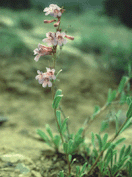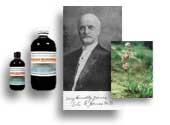

![]()
![]()
 |
At the end of a forty-year career of treating cancer patients, Dr. Eli G. Jones published a book describing his cancer treatments. His final gift to his "brother physicians" was the recipe for the compound syrup scrophularia that he regarded as the most important item in his repertoire of treatments. It took two years to find good sources of the herbs so that each herb could be harvested at the right time and prepared into this tonic. |
This product is a 100% authentic historic replica of the Jones tonic. It is available through practitioners in as an extract or syrup (using honey.) We renamed the product in honor of the Native Americans who shared their knowledge of plants and their medicinal uses with the newcomers to this land.
Jones recommended that patients take a tablespoon three times a day (there are about two tablespoons to a fluid ounce.) Interested persons can compare this to Sundance Elixir , a Hoxsey-like tonic used in a manner similar to Scrophularia Tonic. Our preliminary experience is that Seneca Elixir is more effective where there is lymphatic congestion and/or glandular swelling whereas Sundance is somewhat more detoxifying and pain relieving. Some persons may wish to take both products.ScrophulariaThere are several types of scrophularia, including the Iroquois medicinal plant species, marilandica, specified by Dr. Jones. It is also known as carpenter's square. Some of the other species are more readily available. These include nodosa seen at the top as well as the exotic ningpoensis from Japan. There are many more varieties. The plant obviously gets its name from its use in treating scrofulous conditions, but most people know the common varieties as figwort.
Though very few herbalists use the whole herb, this is what Jones said should be used in his formula. For the record, this is what Maude Grieve also says should be used. Traditionally, it was applied externally on skin disorders or taken internally to relieve everything from eczema and psoriasis to mastitis and chronic lymphatic stagnation. It is with this latter condition that we have had most cause to celebrate. Scrophularia also appears to be an excellent parasiticide, which could explain its effectiveness with cancer as well as a host of other diseases.
Other traditional uses included syphilis, ringworm, and inflammations of the mammary gland. It has been generally believed that scrophularia acts somewhat more slowly than many herbs, but my own experience suggests that there is often truly significant relief in ten days. Dr. John Scudder, 1870, wrote that it has a marked effect in removing cacoplastic (abnormal) deposits.
Our Compound Syrup Scrophularia, called Seneca Elixir, contains: scrophularia (figwort) leaves and roots, phytolacca root, rumex crispus root, celastrus scandens bark and root, podophyllum root, juniper berries, guaiacum wood, and citrus essential oil for flavoring. It is available as an alcohol extract or syrup (using honey rather than sugar.)
Comments:
Being an ancient art and science, herbal medicine often has names for plants that reflect the historic usage. The common name of scrophularia is figwort, but scrophularia itself refers to scrofula and the scrofulous conditions characterized by swelling, especially swelling that in former times was associated with tubercular nodules in the neck. We have not been disappointed. We have found this product to be more effective than Trifolium Compound where there is more swelling and perhaps also therefore more infection but less toxicity. Some people use both tonics because they or their practitioners have deemed this to be suitable. Except for phytolacca, an herb used extensively by Dr. Jones, this formula has very little in common with Trifolium Compound. It is more subtle in its action, and, in my opinion, much more elegant. I have personally consumed countless bottles of it as have many other practitioners who use it as protection against the many conditions to which they are exposed on a daily basis. Unlike the Hoxsey Elixirex, this tonic has not been the subject of either avarice or controversy. It hence does not enjoy either the reputation or research of its cousin. I think of Trifolium Compound as more yang and Compound Syrup Scrophularia as more yin, definitely for those who seek relief that is gentle and unobtrusive.
.
Video capture of the live blood analysis of a patient using this formula
"Cancer
Drops" - called Algonquin Drops
Lymphatic
Ointments
Phytolacca
Syrup
Corydalis
Formosa Tincture
Dioscorea
Tincture
Phytolacca
Cerate
Homeopathic
Thuja 30X
..
.
Sacred
Medicine Sanctuary's Products![]() Herbal
Products and Patents
Herbal
Products and Patents
Hildegard
of Bingen![]() Eli
G. Jones, MD
Eli
G. Jones, MD![]() Compound
Syrup Scrophularia
Compound
Syrup Scrophularia
Algonquin
Drops![]() Lymph
Ointment
Lymph
Ointment![]() Phytolacca
Syrup
Phytolacca
Syrup![]() Other
Jones Formulae
Other
Jones Formulae
Herbal
Tonics![]() Harry
Hoxsey
Harry
Hoxsey![]() Hoxsey
Elixir
Hoxsey
Elixir
Dr.
John Christopher![]() Herbal
Bolus Instructions
Herbal
Bolus Instructions
Ingrid's Cleavers Tea![]() Golden
Myrrical
Golden
Myrrical![]() Indigo
Drops
Indigo
Drops
Boswellia
Serrata ![]() Chaparral
Chaparral![]() Essiac
Essiac ![]() Wormwood
Wormwood
![]()
Much of the material on this site is historic or ethnobotanical in origin. The information presented is not intended to replace the services of a qualified health care professional. All products discussed on this site are best used under the guidance of an experienced practitioner.
We encourage patients and their friends and family to avail themselves of the information found on the Internet and to share their discoveries with their primary care practitioners. If there are questions about the suitability of a product or strategy, please have your practitioner contact the web hostess.
We are interested in feedback, clinical data, suggestions, and proposals for research and product development. While we naturally hope for the happiest outcome in all situations, the authors of this web site, webmaster, server, publishers, and Sacred Medicine Sanctuary are not responsible for the success, failure, side effects, or outcome of the use of any of the information or healing strategies described on this site.
Sacred Medicine Sanctuary
Copyright by Ingrid Naiman 2000, 2001, 2005
*The information provided at this site is for informational purposes only. These statements and products have not been evaluated by the Food and Drug Administration. The information on this page and these products are not intended to diagnose, treat, cure, or prevent any disease. They are not intended to replace professional medical care. You should always consult a health professional about specific health problems.


